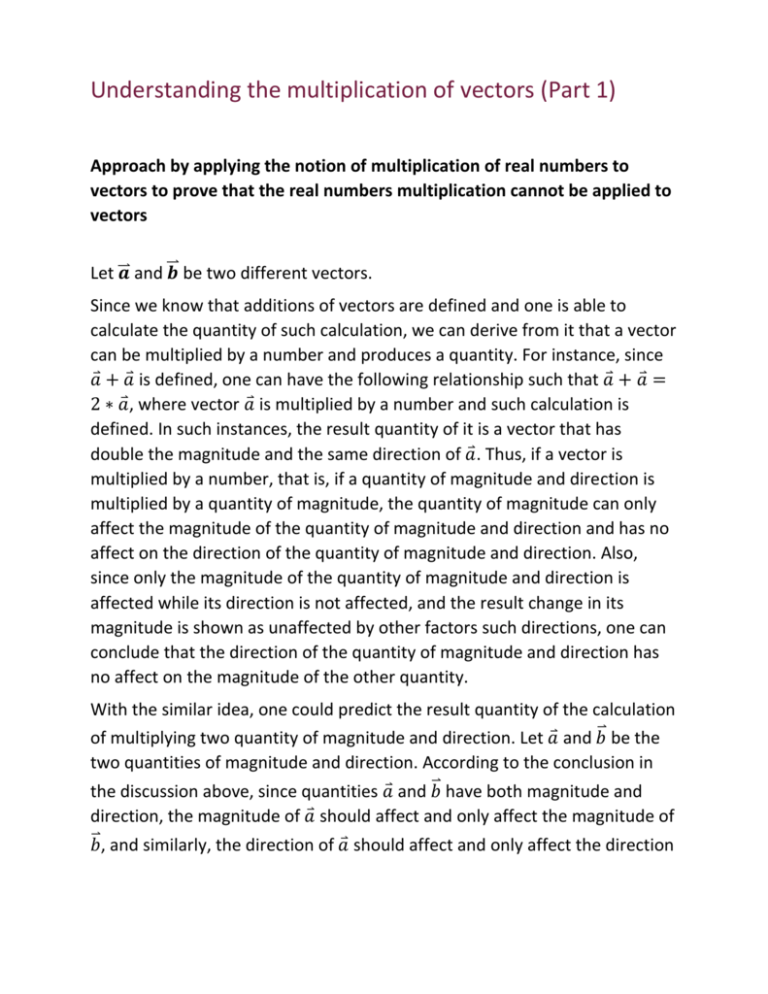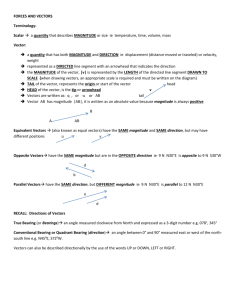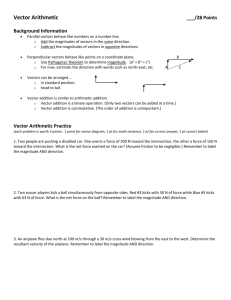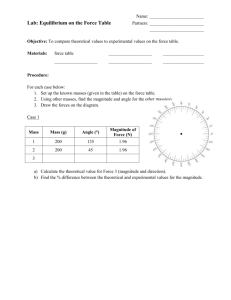3 Understanding the multiplication of vectors
advertisement

Understanding the multiplication of vectors (Part 1) Approach by applying the notion of multiplication of real numbers to vectors to prove that the real numbers multiplication cannot be applied to vectors ⃑ and ⃑𝒃 be two different vectors. Let 𝒂 Since we know that additions of vectors are defined and one is able to calculate the quantity of such calculation, we can derive from it that a vector can be multiplied by a number and produces a quantity. For instance, since 𝑎 + 𝑎 is defined, one can have the following relationship such that 𝑎 + 𝑎 = 2 ∗ 𝑎, where vector 𝑎 is multiplied by a number and such calculation is defined. In such instances, the result quantity of it is a vector that has double the magnitude and the same direction of 𝑎. Thus, if a vector is multiplied by a number, that is, if a quantity of magnitude and direction is multiplied by a quantity of magnitude, the quantity of magnitude can only affect the magnitude of the quantity of magnitude and direction and has no affect on the direction of the quantity of magnitude and direction. Also, since only the magnitude of the quantity of magnitude and direction is affected while its direction is not affected, and the result change in its magnitude is shown as unaffected by other factors such directions, one can conclude that the direction of the quantity of magnitude and direction has no affect on the magnitude of the other quantity. With the similar idea, one could predict the result quantity of the calculation of multiplying two quantity of magnitude and direction. Let 𝑎 and 𝑏⃑ be the two quantities of magnitude and direction. According to the conclusion in the discussion above, since quantities 𝑎 and 𝑏⃑ have both magnitude and direction, the magnitude of 𝑎 should affect and only affect the magnitude of 𝑏⃑, and similarly, the direction of 𝑎 should affect and only affect the direction of 𝑏⃑. That is, to multiply the two vectors 𝑎 and 𝑏⃑, one should multiply both their magnitude and direction individually. In order to do calculations on such quantities, we need to express such quantities numerically; in this instance, we need to express the magnitude and the direction of the two quantities separately. Let |𝑎| be the magnitude of vector 𝑎, |𝑏⃑| be the magnitude of vector 𝑏⃑. Since both vectors are quantities with both magnitude and direction, the direction of them can be shown as such quantities without magnitude; that is, a quantity with a non-existing magnitude and an existing direction. Since the magnitude of such quantity does not exist, in order to do calculations about it for one, one needs a numerical expression of such non-existence according to the calculation it is in. In additions, non-existence is equivalent to zero; in multiplication, nonexistence is equivalent to one, since the existence of these such numbers does not have effects on the original calculations. However, such model produces two essential problems: 1. A quantity with direction but without magnitude carries no significance, since any calculation including addition and multiplication done by such quantity to another quantity has no affect at all. Since such quantity does not have magnitude, it cannot affect other quantity’s magnitude and direction. It cannot change other’s magnitude because a non-existing magnitude ought to have no affect on other’s magnitude through any calculation; it cannot change other’s direction because a change in direction requires calculations done by a quantity with both magnitude and direction: according to the geometric definition of additions of vectors, since one vector has no magnitude, it cannot change the position of the initial vector’s terminal point, thus the result vector remains the same as the initial vector. Since multiplication is essentially the calculation of repeated addition, such conclusion can be applied to multiplication as well. Thus a quantity with direction and without magnitude cannot change other vectors’ direction. 2 2. The multiplication of direction and direction is not defined. According to the discussion above, in order to multiply one vector to another, one should multiply their magnitudes and directions individually since the multiplication between magnitude and direction is not defined. For the multiplication of magnitudes, since magnitudes are real numbers, it can apply the same rule of multiplication of real number and thus it is well defined. Yet for the multiplication of directions, such calculation cannot be defined. The proof of it can be stated as the following: Let O be a vector that has a magnitude of zero. By the definition of multiplication between vectors and real numbers, when a vector is multiplied by a real number n, its magnitude is multiplied by n with its direction unchanged. Thus, any vector multiplied by zero produces the vector O; that is, 0 ∗ 𝑛⃑ = 𝑂. Since the range of choice of the vector 𝑛⃑ that is multiplied is any vector, the direction of O can be any direction and thus it is in indeterminate form. Similar to infinity where one infinity can be larger or smaller than the other, one O can have different direction than the other; since the direction of such vector O is indeterminate, its direction is undefined, and thus no calculations can be applied to its direction. Therefore, because of the problems above appeared in the multiplication of vectors as we apply the notion of multiplication of real numbers to vectors, the multiplication of vectors cannot be defined; in other words, the multiplication applied for real number failed to be applied to vectors. Since so, the special new multiplication for vectors must be introduced in order to compute the multiplication of vectors. 3







